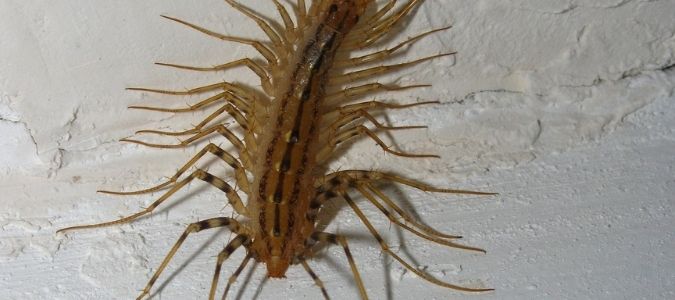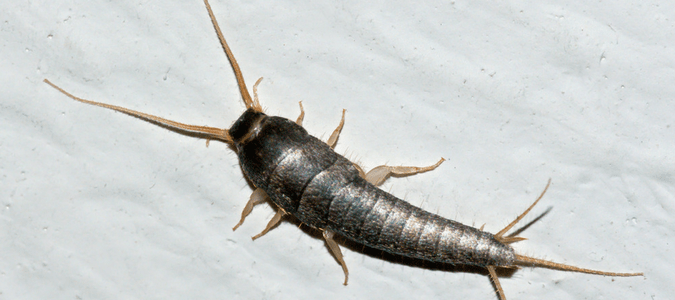You’ve come across some type of bug in your house, and you aren’t sure what it is. All you know is that you want it gone! But what is it, and what impact might it have on you, your family and your home? If it’s small, narrow and long, a pale brownish or grayish color, and has what looks like a lot of legs and antennae, it could be a house centipede or a silverfish.
Whatever it is, you may be wondering how to get rid of it and what you can do to make sure there aren’t more of its kind living and reproducing nearby. Learning the differences between house centipedes and silverfish will help you tell the two apart. Fortunately, both of these pests have distinctive characteristics that make them easy to identify.
Identifying House Centipedes
Like most centipedes, the main identifying characteristic of house centipedes is their many, many legs. The word “centipede” implies that these creatures have 100 legs, but that isn’t always true. The number of legs they have depends on how many segments their bodies have. House centipedes typically have thirty legs along with two antennae. Their bodies grow to about one inch to one and a half inches long. They have long legs, too, reaching out so far from their bodies that they can almost have a hairy appearance. These centipedes are usually a light or medium brown color and may have stripes down their backs, as well as striped legs.
Humid or moist areas can attract centipedes, such as piles of damp leaves outdoors. Indoors, centipedes are also often found in moist environments, like crawl spaces, kitchens and bathrooms. They move quickly on their many legs, though, which means you can find them almost anywhere in the home.
Ironically, the presence of silverfish might attract house centipedes to your home. Some people consider house centipedes “good pests” because they eat other pests you really don’t want in your home. For example, centipedes will happily eat roaches, flies, termites and, yes, silverfish. Still, most people find these creatures undesirable and don’t want house centipedes in their living space, either. A good way to make your home less attractive to house centipedes is to get rid of any other pests your home might be harboring, like silverfish.
Identifying Silverfish
Like house centipedes, silverfish are small, elongated insects that can grow up to about three-quarters of an inch long (so, much smaller than a centipede). Their bodies are a silvery-gray or brownish color and are shaped like a flattened carrot. Silverfish move quickly on their six legs, and when they run, they move in a fishlike, winding motion. They have long antennae as well as long tail-like appendages that they use for sensing. This can make it seem as if silverfish have lots more legs than they actually do.
But, where do silverfish come from? Like house centipedes, silverfish are attracted to moisture. This is why people often find them in bathroom sinks, inside bathroom vanities or under the kitchen sink. If you find lots of silverfish in some area of your home, it can indicate a leak nearby, such as a slowly dripping faucet or pipe. But silverfish don’t just need water to live; they also need food. They feed on starchy items and natural fibers, including sugar, flour and paper. They can chew holes in books and wallpaper and can cause damage if they are able to infest a home.
Fortunately, neither house centipedes nor silverfish is considered a serious threat to people. They don’t typically bite, although a house centipede could bite if it’s picked up and handled. Neither creature carries diseases, although technically centipedes are venomous. Both of these insects are a nuisance, and silverfish can cause extensive damage over time. Both of these creatures can also be a sign of other problems, such as a hidden leak or an infestation of some other type of pest.
How To Make Your Home Less Attractive to Centipedes and Silverfish
To get rid of either silverfish or house centipedes, you’ll need first to reduce moisture throughout your property. Using a dehumidifier and increasing ventilation indoors can help, and it’s important to fix any dripping faucets or leaky pipes. But you should also look outdoors for the source of the problem. If you have wet, rotten wood near your house, or piles of damp leaves, cardboard or other items piled against the house, these could be harboring pests like silverfish and house centipedes. Since they’re so small, it’s very easy for both pests to slip inside from the outside.
It’s also important to get rid of any unneeded paper in the home, such as old magazines or newspapers. Don’t store books or cardboard boxes in areas where moisture can be an issue, like the garage or attic. Instead of using cardboard boxes, opt for plastic or metal containers. In the kitchen, keep all foods stored in airtight containers so that silverfish and other pests, like roaches, rats and mice, can’t access them. Taking these steps will go a long way toward keeping all types of common household pests away.
The good news? Centipedes are actually relatively easy to control. These pests need moisture to survive, so removing any sources of excess moisture should keep centipedes away. Many times, these pests enter homes seeking shelter when it rains. Then, they end up dying due to the low moisture levels in homes. However, if you find that there is an active house centipede population in your home, it likely points to a larger issue.
The bad news? Silverfish are much more difficult to control. Silverfish are nocturnal, so it’s more common to see them at night when you turn on a bathroom or closet light than to see them during the day. Since silverfish move so quickly and are adept at hiding, it can be hard to know how extensive your pest problem is.
Hiring a professional to inspect your home is often the most efficient way to control pests. A pest control specialist can determine what type of insect you’re dealing with, the extent of the infestation and the best products and techniques to get rid of them.
Silverfish are often found in areas of the home where there is moisture, such as in bathrooms and kitchens. But, it’s not uncommon to find them in your closet as well.
Do Silverfish Eat Clothes?
If you flip on the closet light and catch sight of a silverfish running to hide in a dark corner, you might wonder: “Do silverfish eat clothes?” Unfortunately, the answer is that silverfish can and do eat clothing, as well as other items made of fabric like sheets, towels and blankets. Silverfish also feed on paper and even human food items like sugar, flour and bread.
While silverfish aren’t known disease carriers, they can cause damage if they’re able to infest a home. They can also contaminate food in your pantry, so it’s wise to keep all food stored in containers with tight-fitting lids. Silverfish eat the paper found in books, as well as the glue that holds their binding together. So, bookcases and boxes of books are another place where you might have a silverfish infestation. Since they eat cardboard, silverfish might live in boxes of stored items, especially things made of paper or fabric.
It’s important to keep these pests from destroying your belongings, and there are several steps you can take to protect your things. First, fix any moisture issues you may have indoors from leaky faucets or pipes. Using a dehumidifier can also help a lot. Next, try not to store books or anything else in cardboard boxes in areas that silverfish are attracted to, like the attic or garage. Reducing clutter from old clothes, linens, books, magazines and newspapers will also help keep silverfish away.
All these are most effective when they are complementing a larger pest control strategy. If you have a silverfish infestation, it’s wise to enlist the help of a pest control professional to get rid of the pests. A professional can also help you identify elements in your home that might be attracting silverfish, and can provide ongoing treatments to keep pests away in the future.
Silverfish Egg Sac or Something Else?
Finding an egg sac in your house is an unsettling experience, since it means some type of unwanted bug is reproducing inside your home. If you think you’ve found a silverfish egg sac, it’s probably an egg sac from some other type of pest, like a cockroach, because silverfish don’t actually lay eggs in sacs. They lay tiny, whitish or yellowish eggs, usually in pairs, and usually in dark cracks and crevices where people never find them. Roach egg sacs are very small, brown or black in color, and oval or rectangular in shape. They look a lot like a dark-brown Tic-Tac candy.
A silverfish egg may take a month or two to hatch. Once hatched, silverfish go through several stages of nymphs before becoming a full-grown adult silverfish. Nymphs look a lot like adult silverfish, just much smaller. If you find silverfish eggs, nymphs or adults in your home, it’s time to contact a pest control specialist to help you determine the extent of your needed pest control treatment plan. A professional can apply proven solutions throughout your home for silverfish and can also schedule follow-up visits to make sure your silverfish problem doesn’t return.
ABC Can Treat and Prevent Pest Problems in Your Home
Nobody likes finding creepy-crawlies in their home—especially when these pests have so many appendages! Fortunately, ABC Home & Commercial Services has all the tools and products needed to control these pests. We also offer ongoing pest management, so you can have fewer run-ins with uninvited guests going forward.





